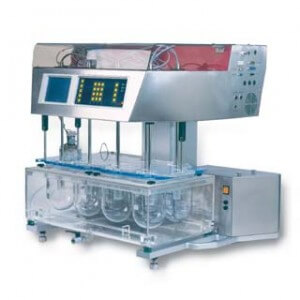Dissolution Area
This is the area for In-Situ Tablet Dissolution Testing Instruments or fibre optic dissolution. IDS1000 or In Situ Dissolution System or fibre optic dissolution is about the application of direct measurement technology to Dissolution Testing by using Fibre Optic Probes.

Traditionally
Traditionally, dissolution testing has been carried out on solid dosage forms using a standard dissolution tester. Samples of the dissolving active within the dosage form are taken for estimation from the dissolution tester either manually, or using more automated means such as a pump which has been connected to a suitable measurement device, usually a UV-VIS Spectrophotometer.
Overview
Using IDS1000 and the IDS Dissolution Software, not only can the whole process of sample measurement be automated, but can also be self contained, such that there is no need for samples to be pumped out of the dissolution vessels to external measure-ment facilities such as a Spectrometer, because all that is needed for the measure-ments to be made is contained within the confines of the instrument itself.
The system control functions are provided by the IDS Dissolution Software a fully 21 CFR part 11 (GAMP) compliant software package suitable for in-situ and closed system operation.
Software Control
The system control functions are provided by the IDS Dissolution Software a fully 21 CFR part 11 (GAMP) compliant software package suitable for in-situ and closed system operation.
Click here for more info
IDS1000 Fibre Optic Dissolution Testing
Fully Automated In-Situ Dissolution Testing
In Situ Dissolution using Fibre Optic Probes directly insde the dissolution vessels is probably the most interesting development to happen in the dissolution technology regime for some time. The attraction of this type of system is many fold. For most R&D and QC labs that have one, it is abundantly clear that there is such a great advantage in faster sampling information, saved time during test to test cleaning, saved time in terms of system qualification compared with a “classic” automated dissolution system. Qualification of automated systems with a pumped liquid flow takes up a lot of time and of course there is the inevitable need for sample tubing changes, filter changes, pump tubing changes and so on. There is therefore a very substantial cost and time saving which can easily be offset against the investment cost of the instrument itself. Then there is the greater sample throughput available with these types of systems. Easy system calibration routines, coupled with straightforward probe normalisation programs mean that the instrument is ready for action with relatively little down time between runs. Established SOP’s can be easily translated into the in situ type systems without recourse to method re-submission.
In fact the ROI (Return on Investment) time can be as little as 12 to 18 months. The attraction does not stop there. With an ever growing number of fast release products and the inherent difficulties in handling slow release products at the other end of the “dissolution spectrum”, the versatility offered by In Situ systems is becoming more and more evident.
A conventional dissolution system with a cell changer and a classical spectrometer needs approximately 3 to 5 minutes for a complete measurement cycle for 6 samples, plus Blank and Standard Media; the IDS1000 can manage this in anything from 10 to 30 seconds including a full spectrum collection at each position and full data evaluation. This offers an increased data acquisition rate of approximately 10 to 30 times.
In the case of slow release products, the in situ positioning of the fibre probes inside the stirrer hollow shafts combined with the particle light scattering compensation routines, means that filming over of sensor mirrors and excipient effects (with scattered rather than absorbed light) can be effectively eliminated.
All components (including DAD spectrometer) are mounted within the dissolution tester main frame. The footprint of the integrated system is therefore smaller, even compared to other fibre optic based systems. New vibration handling hardware means that even vibration from other sources in the lab such as pumps and so on, is virtually eliminated. Easy access racks for both pump and heater as well as power control electronics makes for fast and reasonable cost maintenance.
Request a quote or more information
Would you like to request a quote or more information?
Contact us:
Phone: +31 (0)162 383100
or use our contactform


